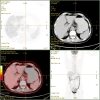Primary Adenocarcinoma of the Lesser Omentum: A Case Report
- PMID: 40206575
- PMCID: PMC11978730
- DOI: 10.1002/ccr3.70408
Primary Adenocarcinoma of the Lesser Omentum: A Case Report
Abstract
Adenocarcinoma of the lesser omentum is a rare malignant tumor. Because of its rarity, unusual origin, and possibly diverse symptoms, this malignancy poses significant challenges in both diagnosis and treatment, and prognosis can vary widely among individuals. This report aims to enhance understanding and provide insights into future treatment.
Keywords: adenocarcinoma; case report; image reconstruction; omentum.
© 2025 The Author(s). Clinical Case Reports published by John Wiley & Sons Ltd.
Conflict of interest statement
The authors declare no conflicts of interest.
Figures



Similar articles
-
A Case of KIT-Negative Extra-Gastrointestinal Stromal Tumor of the Lesser Omentum.Case Rep Gastroenterol. 2012 May;6(2):375-80. doi: 10.1159/000337908. Epub 2012 Jun 19. Case Rep Gastroenterol. 2012. PMID: 22855655 Free PMC article.
-
Giant extra gastrointestinal stromal tumor of lesser omentum obscuring the diagnosis of a choloperitoneum.Int J Surg Case Rep. 2013;4(10):818-21. doi: 10.1016/j.ijscr.2013.07.006. Epub 2013 Jul 24. Int J Surg Case Rep. 2013. PMID: 23959407 Free PMC article.
-
Malignant gastrointestinal stromal tumor originating in the lesser omentum, complicated by rapidly progressive glomerulonephritis and gastric carcinoma.Intern Med. 2004 Feb;43(2):102-5. doi: 10.2169/internalmedicine.43.102. Intern Med. 2004. PMID: 15005250
-
Carcinosarcoma of the Lesser Omentum: A Unique Case Report and Literature Review.Medicine (Baltimore). 2016 Apr;95(14):e3246. doi: 10.1097/MD.0000000000003246. Medicine (Baltimore). 2016. PMID: 27057865 Free PMC article. Review.
-
Primary omental malignant solitary fibrous tumour, an extremely rare malignancy: A case report and review of the literature.Arab J Gastroenterol. 2019 Jun;20(2):114-116. doi: 10.1016/j.ajg.2018.12.001. Epub 2019 Feb 4. Arab J Gastroenterol. 2019. PMID: 30733179 Review.
References
-
- Qi L., Xiao W., and Zhang G., “Analysis of 4 Cases of Misdiagnosis of Abdominal Masses,” Chinese Journal of Misdiagnostics 10, no. 12 (2010): 2903–2904.
-
- Weng W., Wu J., Zhao L., Dong L., Yu G., and Chen L., “CT Diagnosis of the Lesser Omentum Tumor,” Journal of Medical Imaging 20, no. 12 (2010): 1847–1849.
-
- Fenzl V., Prkacin I., and Skrtic A., “Malignant Melanoma Ovarian Metastasis Mimicking Acute Tuboovarian Abscess,” European Journal of Gynaecological Oncology 32, no. 5 (2011): 582–584. - PubMed
LinkOut - more resources
Full Text Sources

